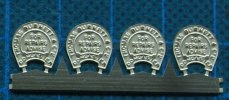Thanks every one for your respective suggestions, experiences with various etching firms, and views on the best way forward, it is much appreciated.
I like the idea of peer review.
It is one of those cases where I know exactly what I want, I now have access to reliable drawings and photographs, but am struggling to know how best to obtain the parts I would like. May be others have the same problem with this and other areas of modelling.
My CAD drawings will be, when completed, a mixture of 7mm scale private owner wagon builders/owners plates, Midland Railway number and registration plates, plus parts to build an 1890's MR tank wagon, all requiring two different thicknesses of brass - looking at the material available from PPD may be I'm best with 0.45mm (17 thou.) for the components and 0.25 or 0.30mm (9.8mm or 11.8mm) for the plates.
Tony

